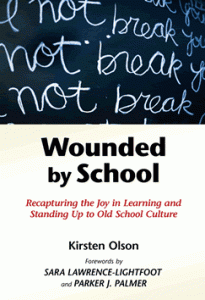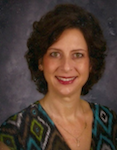Wounded by School: Broken, then Healing
Wounded by School: Recapturing the Joy in Learning and Standing Up to Old School Culture
by Kirsten Olson
(Teachers College Press, 2009 – Learn more)
With my own child “wounded” by school and working with children on a daily basis who face the same challenges of having a learning difference, attention deficit, or just a plain dislike for school, I felt this would be an energizing and supportive book for me as a parent and teacher. But I was frustrated by what seemed to me a negative tone on the part of the author toward the teaching profession.
This text is divided into two main parts: Broken and Healing. These two sections are then divided further to describe wounded students as well as wounded parents. Olson also includes a description of the types of wounds afflicting our students. Wounded by School then progresses to the process of healing. Along with these descriptions are learning stories by some of the “wounded” and eventually “healed.”

Many of the “wounds” Olson describes are those caused by poor policy or poorly qualified teachers.
- Individuals not reflecting on their personal practices to develop deeper understandings of student reluctance
- Pulling students out of “regular” instruction
- Labeling students
- Not building personal relationships
- Not allowing students to express themselves through their own learning styles
- Testing, testing, and more testing!
- Extrinsically motivating students
- Negative comments by teachers or the “red” pen
- Classes lacking appropriate amount of stimuli
- Calling students out for their errors in front of their classmates
“Healing” progresses through stages. These stages are defined and include excerpts from more personal learning stories. Again, much of the text emphasized the idea that schools and teachers need to change, and suggestions were provided. In addition, there was an explanation of how parents and the “wounded” evolve to being advocates and very successful adults.
- Praise children for specific efforts, not generalized abilities or talents
- Suggest looking at mistakes as opportunities for learning
- Encourage students to know and advocate for their own needs
- Make learning available through approaches based on brain research
- Use technology to the fullest advantage to teach and learn through multi-modalities
- Provide students with opportunities for success
- Teachers should “connect” with students as teammates, not enemies or lesser people
Olson offers very few positive words about those teachers and parents who do form a partnership to positively impact students with learning differences and to make connections with them. Many practitioners already possess diagnostic skills and reflect on each student to provide instruction and learning environments based on brain research.
While reading the book challenged me greatly because of my own internal struggles with education as a parent and teacher, I do believe it would be valuable reading for those who have been “wounded.” Olson does provide hope through the learning stories. In addition, policy makers and administrators could benefit from this text — it could make them more aware of changes that are greatly needed. Finally, it wouldn’t hurt to share this information with ineffective or poorly qualified teachers.
I conclude with a very powerful quote from Olson:
“Without the skills and knowledge to construct meaningful lessons, and lacking a commitment to student unwounding, teachers have much power to harm. Their moral and intellectual powers rightly aligned, they also have the power to inspire and transform.”
Lorie Shiveley is a National Board Certified Teacher and currently teaches eighth grade Language Arts. She has held a variety of teaching positions instructing elementary, middle school, and undergraduate education students. Her passion for assisting students to become the best they can possibly be has kept her in the teaching profession for 20 years.





































